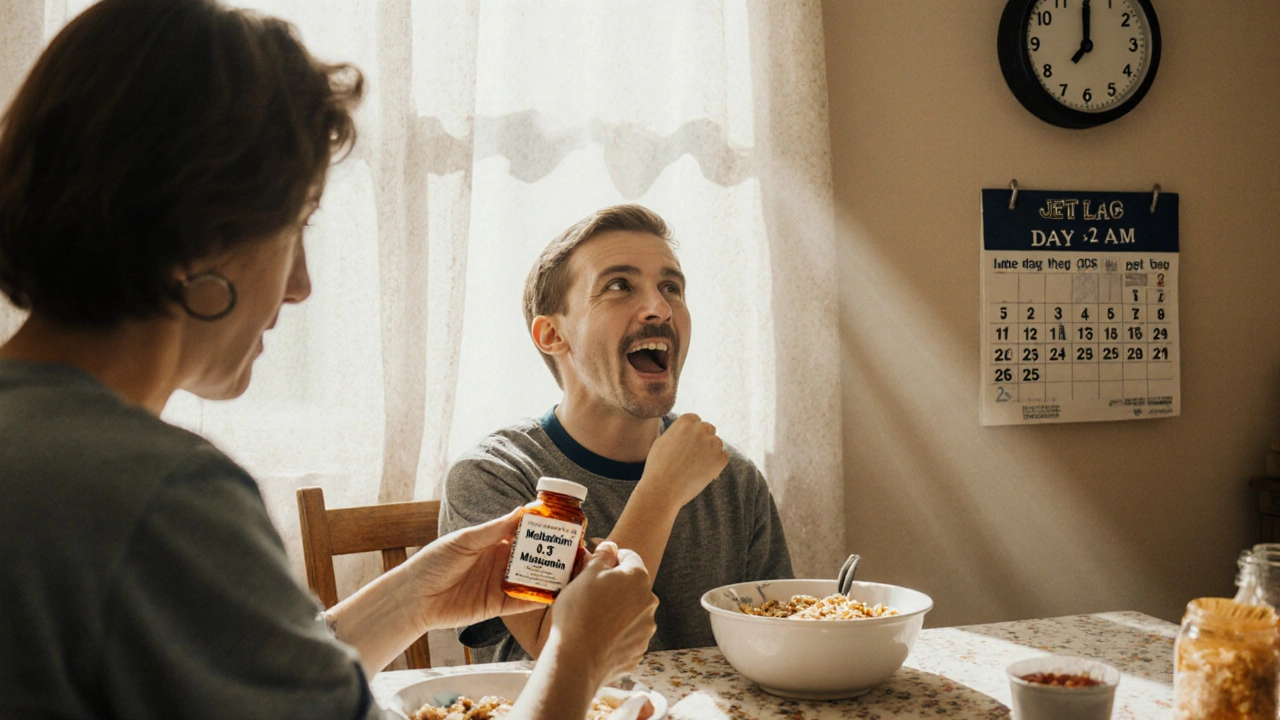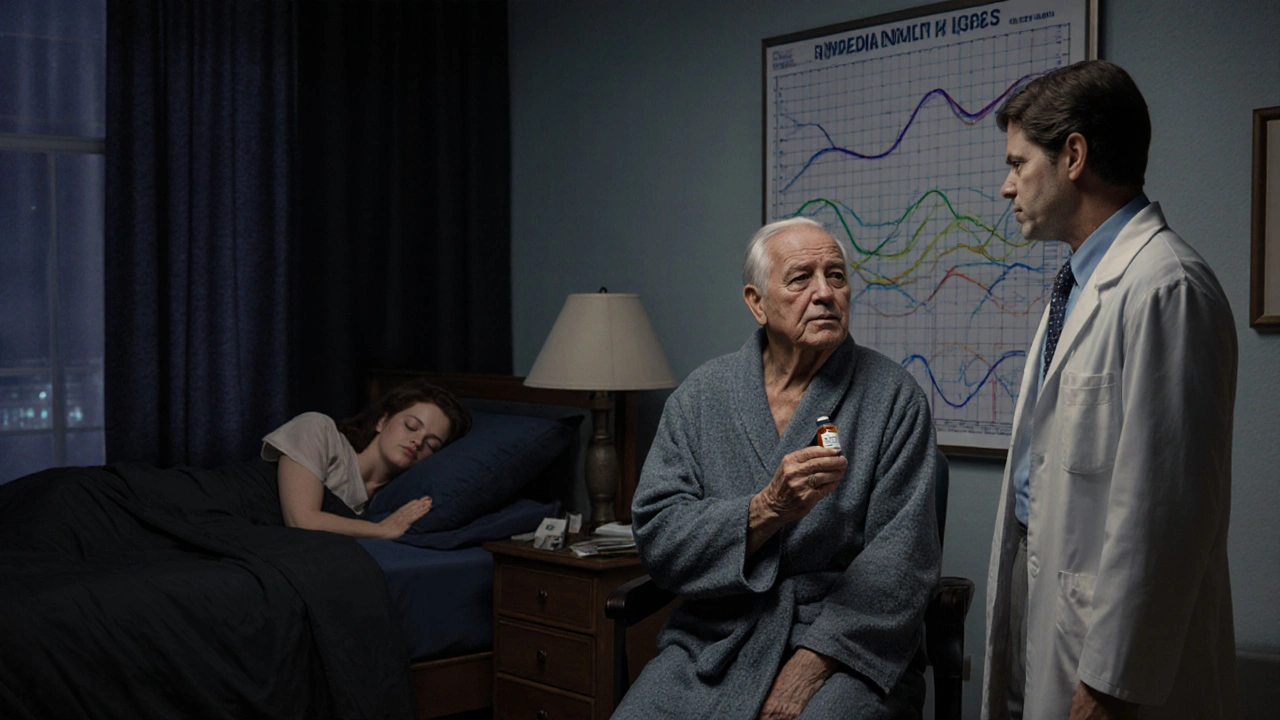Melatonin: How This Natural Sleep Hormone Really Works and When It Actually Helps
 Nov, 22 2025
Nov, 22 2025
Most people think melatonin is a sleeping pill. It’s not. It’s your body’s natural melatonin signal - a chemical that tells your brain it’s time to wind down. When the sun sets, your pineal gland releases it. No light, no melatonin. That’s why staring at your phone at midnight throws your whole sleep system off. But here’s the thing: taking a melatonin supplement doesn’t make you sleepy like a pill does. It tells your internal clock, ‘Hey, it’s nighttime now.’ And that makes all the difference.
How Melatonin Actually Works in Your Body
Melatonin isn’t a sedative. It doesn’t knock you out. It’s a timing cue. Your brain produces it naturally in response to darkness. Levels start rising around 9 PM, peak between 2 and 4 AM, then drop before sunrise. In healthy adults, that peak is between 50 and 150 picograms per milliliter of blood. That’s tiny - less than a grain of salt in a swimming pool. But it’s enough to shift your whole rhythm.
The magic happens in the suprachiasmatic nucleus (SCN), a tiny cluster of cells in your brain that acts as your master clock. Melatonin binds to two receptors there: MT1 and MT2. MT1 tells your neurons to calm down, lowering your core body temperature by about half a degree Celsius. That’s why you feel sleepy. MT2 adjusts your internal clock - pushing it earlier or later depending on when you take it. Take it too late, and you delay your rhythm. Take it too early, and you shift it forward. Timing matters more than dose.
Why Melatonin Works for Some Sleep Problems - and Not Others
If you struggle to fall asleep because your brain won’t shut off, melatonin won’t fix that. But if your body thinks it’s 3 AM when it’s really 11 PM - that’s where melatonin shines.
For delayed sleep phase syndrome (DSPS), where you naturally fall asleep at 2 AM and can’t wake up until noon, melatonin is one of the few proven tools. Studies show taking 0.5 mg two to three hours before your target bedtime can shift your rhythm by 40 to 70 minutes over a few weeks. One Reddit user, SleepyScientist, wrote: “Took 0.5 mg at 9 PM every night. In three weeks, I was falling asleep at 11 PM without effort.” That’s not luck. That’s circadian retraining.
For jet lag, especially flying east, melatonin works better than most sleep aids. When you fly from Brisbane to London, your body still thinks it’s 10 PM. Taking 0.5 mg at local bedtime for the first two nights helps your clock catch up. A verified Amazon review from TravelNurseAmy said: “Took 1 mg at London bedtime after my eastbound flight. Adjusted in two days instead of five.”
But for general insomnia - lying awake for hours with racing thoughts - melatonin does almost nothing. A 2013 Cochrane review found it reduces sleep onset time by just over 7 minutes on average. That’s less than a prescription sleep pill, which cuts it by 20 to 30 minutes. The American Academy of Sleep Medicine doesn’t recommend melatonin for insomnia. It recommends it for circadian disorders. Big difference.
The Dose Trap: Why More Isn’t Better
Most melatonin supplements in the U.S. come in 3 mg, 5 mg, even 10 mg. That’s 20 to 100 times more than your body makes naturally. And it doesn’t help. In fact, it hurts.
Research from Dr. Neil Stanley and others shows doses above 0.5 mg offer no extra benefit. Higher doses just increase side effects: next-day grogginess (28% of users), vivid dreams or nightmares (22%), headaches (15%). One analysis of 3,147 user reviews found people taking 5 mg or more were twice as likely to report morning fog.
Why do companies sell high doses? Because they can. In the U.S., melatonin is sold as a dietary supplement under the 1994 DSHEA law. That means no FDA approval, no standardization. ConsumerLab tested 28 top-selling brands in 2022 and found melatonin content ranged from 83% to 478% of what was on the label. One pill labeled 3 mg had 14 mg. Another had 0.4 mg. You’re guessing.
Start with 0.3 mg to 0.5 mg. If that doesn’t help after a week, try 1 mg. Anything over 3 mg is unnecessary and risky. The European Medicines Agency approves only a 2 mg prolonged-release version - and only for people over 55 with insomnia. That’s the gold standard. U.S. products are not.

When and How to Take It - The Real Rules
Timing is everything. Taking melatonin at 11 PM when you want to sleep at 10 PM? That’s too late. You’ll delay your rhythm instead of advancing it.
For DSPS or shift work: Take it 2 to 3 hours before your target bedtime. If you want to sleep at 10 PM, take it at 7 PM. That gives it time to bind to receptors and signal your brain to start cooling down.
For jet lag:
- Flying east? Take melatonin at local bedtime for 2-3 days before departure and after arrival. Your body needs to shift earlier.
- Flying west? Take it at local bedtime after arrival. You’re trying to delay your clock, so light exposure in the morning helps more than melatonin.
And dim the lights. Even a little light from a nightstand lamp can block melatonin. Use red or amber bulbs if you need light after taking it. Blue light - from phones, TVs, LEDs - is the worst. It suppresses melatonin more than any other wavelength.
Who Shouldn’t Take It - And Who Benefits Most
Melatonin isn’t for everyone. It’s not a magic sleep potion. It’s a tool for specific biological mismatches.
Best candidates:
- People with delayed sleep phase syndrome
- Travelers crossing 3+ time zones (especially eastbound)
- Shift workers with rotating schedules
- Blind individuals with non-24-hour sleep-wake disorder
Avoid it if you:
- Have autoimmune diseases (melatonin can affect immune response)
- Are pregnant or breastfeeding (not enough safety data)
- Take blood thinners or immunosuppressants (potential interactions)
- Have depression (some studies link high melatonin to worsening symptoms)
Usage is highest among adults 35 to 54 - the group most likely to have disrupted routines from remote work, screen time, and stress. In 2022, 3.1% of U.S. adults used melatonin regularly - about 8 million people. That’s up from 2.1% in 1999-2002. Demand is rising because modern life breaks our natural rhythms.

The Future: Precision Melatonin, Not Blunt Doses
Scientists aren’t just selling more pills. They’re building better tools.
Agomelatine, approved in Europe, combines melatonin receptor action with serotonin modulation. It treats depression without causing drowsiness. Tasimelteon, approved by the FDA for blind people, gives precise circadian shifts with fewer side effects. These aren’t melatonin supplements. They’re targeted therapies.
The National Institutes of Health is funding 17 trials right now - looking at melatonin for Alzheimer’s, long COVID sleep issues, and even irritable bowel syndrome. The goal isn’t to make everyone sleep better. It’s to fix broken clocks.
As Dr. Jamie Zeitzer from Stanford says, melatonin’s future isn’t in 5 mg gummies. It’s in personalized timing, based on your unique chronobiology. We’re moving from “take a pill when you can’t sleep” to “fix your rhythm so you don’t need the pill.”
What to Do If Melatonin Doesn’t Work
If you’ve tried 0.5 mg at the right time, for at least a week, and nothing changed - it’s not working for you. That’s normal. Not everyone needs it.
Try this instead:
- Get bright natural light within 30 minutes of waking - even on cloudy days
- Keep your bedroom cool (18-20°C) and pitch black
- Stop screens 90 minutes before bed - use blue light filters if you must
- Go to bed and wake up at the same time every day, even weekends
- If you’re still awake after 20 minutes, get up. Read under dim light. Don’t lie there stressing
These habits fix the root cause - not the symptom. Melatonin is a bridge, not a home.
Is melatonin safe for long-term use?
There’s no strong evidence that melatonin causes dependence or withdrawal like prescription sleep drugs. But long-term safety data is limited. Most studies last only a few weeks to months. For regular use beyond 3 months, consult a sleep specialist. Avoid high doses - they may reduce receptor sensitivity over time. Some users report diminishing effects after 4 to 8 weeks, suggesting possible tolerance.
Can melatonin help with anxiety or depression?
Melatonin isn’t an antidepressant or anti-anxiety medication. Some people feel calmer because better sleep reduces stress, but melatonin doesn’t directly treat mood disorders. In fact, high doses may worsen depression in some individuals. Agomelatine, a prescription drug that acts on melatonin receptors, is used for depression - but it’s not the same as over-the-counter melatonin supplements.
Why do some people get vivid dreams or nightmares with melatonin?
Melatonin increases REM sleep - the stage where most dreaming happens. Higher doses can intensify dream activity. This isn’t dangerous, but it can be unsettling. Reducing your dose to 0.3-0.5 mg often eliminates this side effect. If dreams persist, stop taking it. Your body may just be adjusting.
Is there a difference between fast-release and extended-release melatonin?
Yes. Fast-release works quickly to help you fall asleep. Extended-release mimics your body’s natural slow release of melatonin and may help you stay asleep longer. For jet lag or delayed sleep phase, fast-release is usually better. For trouble staying asleep, extended-release may help - but only if your sleep maintenance issue is tied to low nighttime melatonin levels, which is rare. Most insomnia isn’t.
Can kids take melatonin?
Some children with neurodevelopmental disorders like autism or ADHD may benefit from low-dose melatonin under medical supervision. Studies show it can help them fall asleep faster. But for healthy kids with normal sleep patterns, melatonin isn’t recommended. Their bodies produce enough. Poor sleep in kids is usually caused by screen time, inconsistent routines, or anxiety - not low melatonin. Always talk to a pediatrician before giving it to a child.
Does melatonin help with shift work?
Yes, especially for night shift workers trying to sleep during the day. Taking 0.5-3 mg before daytime sleep can help align your internal clock with your schedule. Combine it with blackout curtains and white noise for best results. Studies show shift workers who use melatonin report better sleep quality and less fatigue. But it doesn’t eliminate the health risks of working nights - just helps manage sleep.
